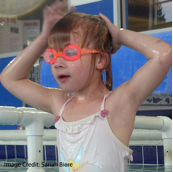By Smarty Guest Blogger, Little Otter Swim School
Watching and doing makes learning something we do together.
What we see affects everything we do and even some things that we think. But we don’t just “see”. Part of our “sight” is learned and it is called visual recognition. This begins at a very early age. As soon as infants can focus their eyes, they begin to recognize objects, colors and people. Infants begin to recognize that others do and eventually if they are or can do the same things that others do. We all began learning activities by mimicking what others are doing – whether it be our instructors or others who are learning.
This is especially true in learning to swim.
Instructors can describe swim stokes or even actions like putting your face in the water in great detail with words, but watching an instructor do that same activities is more immediately understood and replicated.
A picture is really worth a thousand words in this case.
This is true for more than just students. Consider the training that you do for staff and new instructors. Is it better to tell them what they need to do without having them observe another instructor in action? Of course not. One of the best ways to learn and understand teaching is to observe. With swim instructors, we take this one step further. After observing from the pool deck, instructor trainees observe in the pool. This helps them to closely observe important methods like those for supporting their strokes or helping them improve their form. This method has an added benefit. Students have an opportunity to warm up to the new instructor as they gradually become engaged in the class.
Regardless of who is learning, visual recognition helps students to understand – quickly and clearly – expectations.
In fact, many instructors – whether in swimming or other children’s activities – are adopting or have already adopted the read it, see it, do it learning style. It is proving itself to be very effective in helping to make learning:
– Stickier (we remember and can replicate what we do better than what we hear)
– Faster (we immediately understand when we demonstrate)
– Broader (an entire class can learn as they mimic one instructor)
Demonstration and mimicking makes a connection with children.
When you use learning styles that require that your students participate, a stronger connection is made with them. Trust and confidence blossom and rapport with them is developed very quickly. You and your instructors and your students benefit since you’re learning together.
Learn more about swim lessons that are available at one of the area’s best children’s swim resources – Little Otter Swim School – with locations in Matthews or Huntersville – where the passion for teaching quality swimming is obvious. www.littleotterswim.com
![]()
Little Otter Charlotte
8200 Tower Point Drive
Charlotte, NC 28227
Little Otter Huntersville
14415 Reese Boulevard
Huntersville, NC 28078



